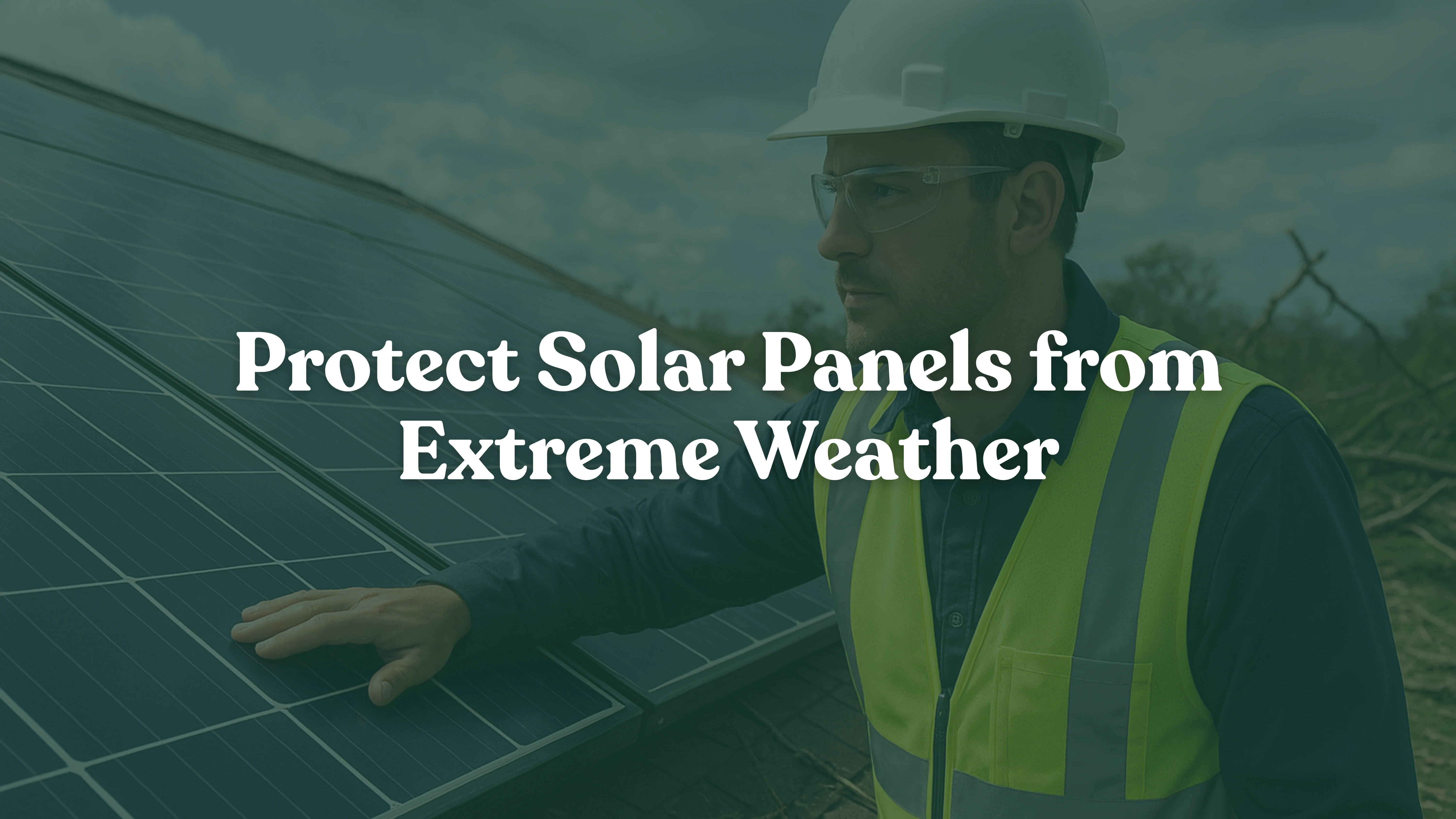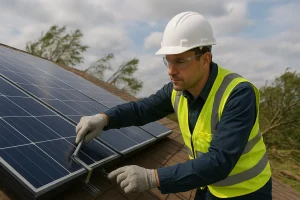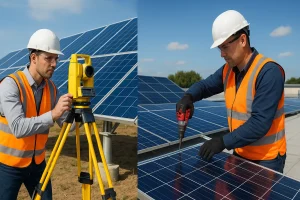How to Protect Your Solar Panels from Extreme Weather Conditions

Protect Solar Panels from Extreme Weather: Complete Guide
Extreme weather events are becoming increasingly common across the United States, creating urgent challenges for solar installers and EPCs. From hurricane-force winds exceeding 150 mph to golf-ball-sized hail traveling at 70+ mph, protecting solar panels from severe weather conditions has never been more critical. However, with proper planning, quality materials, and proven protection strategies, you can deliver solar systems that not only survive nature’s most destructive forces but continue generating clean energy for decades to come. This comprehensive guide shows you exactly how to protect solar panels against extreme weather threats.
Understanding Weather-Related Risks to Solar Panel Systems
Wind Damage: The Primary Threat to Solar Installations
High winds pose the most significant threat to solar installations across America. When you protect solar panels properly, they can withstand winds up to 150 mph, but proper installation techniques are crucial for achieving these ratings.

Most quality solar panels meet these wind resistance standards:
- 5,000+ Pa (200+ mph): Premium manufacturers like Silfab Solar
- 4,000 Pa (150 mph): Mission Solar, Q Cells, REC, SunPower
- 2,400-3,000 Pa (125+ mph): Trina, Panasonic, Canadian Solar
Hail Impact: Growing Concern in Hail Alley
The greatest contributor to insured losses on solar PV systems worldwide is severe hail. States like Texas, Colorado, and Nebraska regularly experience damaging hail storms that can destroy unprotected solar arrays. Learning how to protect solar panels from hail damage is essential for installers in these regions.
Modern solar panels undergo rigorous testing:
- UL 61730/IEC 61730 certification: Withstands 1-3 inch hail at 88.3 mph
- Tempered glass protection: Up to 6 times stronger than regular glass
- Real-world performance: NREL’s 3,000+ panel array sustained only one damaged panel during a severe Colorado hailstorm
Snow Load and Ice Accumulation Challenges
Heavy snow creates both mechanical stress and performance issues. Studies have shown that snow events can cause the biggest challenges to solar power’s performance in extreme weather. When you properly protect solar panels through design, proper tilt angles and robust racking systems become essential for snow-prone regions.
Essential Design Strategies for Weather Resilience
Selecting Weather-Resistant Solar Panels
When specifying panels for extreme weather zones, prioritize these features to effectively protect solar panels:
Premium Glass Options
- 4mm tempered glass: For hail-prone zones, installers should choose PV modules with 4mm front glass thickness to protect solar panels from hail damage
- Impact resistance ratings: Look for UL 61730 or IEC 61730 certification
- Temperature coefficient: Choose panels with low temperature coefficients (-0.32% per °C) for hot climates
Frame and Construction Quality
- Reinforced aluminum frames
- Marine-grade anodizing for coastal installations
- Certified wind load ratings exceeding local building codes
Advanced Mounting System Selection
Critical fastened joints are defined as the assembly of fastened components whose failure will result in catastrophic system loss. Your mounting system choice directly impacts your ability to protect solar panels effectively.

Ground-Mount Considerations
- Deep concrete foundations below frost line
- Cross-bracing for lateral stability
- Ballasted systems with mechanical attachments for uplift protection
Rooftop Installation Best Practices
- Penetrating mounts with structural attachments
- Avoid fully ballasted systems on commercial roofs
- Strategic mechanical attachment placement to protect solar panels
Optimal Tilt and Orientation for Weather Protection
Hail Protection Through Strategic Tilt Compared to flat installations, tilting panels at 60° can increase survival likelihood from 82% to 99% during hail events. While 60° isn’t practical for most installations, higher tilt angles significantly help protect solar panels from hail damage.
Snow Management Strategies
- Minimum 30° tilt in snow-prone regions
- Consider heated panel options for extreme snow areas
- Plan for snow guards on adjacent roof sections
Proactive Protection Measures
Storm Preparation Protocols
Tracking Systems Protection Implement “hail stow” positioning that tilts panels to near-vertical during severe weather warnings. This reduces hail impact surface area and wind uplift forces, helping protect solar panels during extreme weather.
Temporary Protection Options
- Hard shell covers for high-value installations
- Hail netting systems for solar farms
- Retractable covering systems for commercial arrays
Regular Maintenance and Inspection
Post-Storm Assessment to Protect Solar panels Perform IR, UV, or EL scans of panels within one month of weather events to look for invisible damage. Microcracks may not be immediately visible but can compromise long-term performance and your ability to protect solar panels over time.
Preventive Measures
- Quarterly visual inspections
- Annual thermal imaging scans
- Immediate post-storm damage assessment protocols
Insurance and Warranty Considerations
Understanding Coverage Gaps
Most manufacturer warranties exclude weather damage, making proper insurance coverage essential when you protect solar panels. Work with clients to ensure:
- Comprehensive property insurance covers solar installations
- Coverage limits match full replacement costs
- Weather-related damage is specifically included as covered perils
Documentation Requirements
Maintain detailed installation records to protect solar panels investments:
- Engineering calculations for wind loads
- Material certifications and test reports
- Installation photos showing proper mounting techniques
Regional Weather Adaptation Strategies
Hurricane-Prone Coastal Areas
Florida’s building codes require solar systems to withstand 160+ mph winds. Apply these standards even in areas with less stringent codes to properly protect solar panels:

- Use marine-grade materials throughout
- Implement multiple attachment points per panel
- Plan for extended power outages with battery backup systems
Tornado Alley Considerations
76% of tornados have wind speeds ranging between 40-112 mph, and most solar panels are certified to withstand winds of about 140 mph. Focus on strategies that protect solar panels in these regions:
- Reinforced ground-mount foundations
- Quick-disconnect systems for mobile installations
- Underground electrical runs where possible
High-Altitude and Cold Climate Adaptations
Mountain and northern installations require special consideration to protect solar panels from:
- Extreme temperature cycling
- Heavy snow and ice loads
- UV exposure at high altitudes
Future-Proofing Solar Installations
Climate Change Adaptation
The rising frequency and severity of climate change-induced extreme weather events—such as hurricanes, floods, heatwaves, and snowstorms—demands forward-thinking approaches to protect solar panels.
Consider these emerging trends:
- Smart monitoring systems with weather integration
- Automated protective positioning systems
- Enhanced material specifications beyond current minimums
Technology Integration
Modern installations that effectively protect solar panels benefit from:
- Real-time weather monitoring integration
- Automatic system shutdowns during severe weather
- Remote damage assessment capabilities
Economic Considerations for Weather Protection
Cost-Benefit Analysis
While weather-resistant components increase upfront costs, they provide significant long-term value when you protect solar panels properly:

- Reduced insurance premiums
- Lower maintenance costs
- Extended system lifespan
- Improved customer confidence and referrals
Value Engineering Approaches
Balance protection with economics to protect solar panels cost-effectively:
- Risk assessment based on local weather data
- Tiered protection levels based on installation value
- Phased upgrade strategies for existing systems
Conclusion: Building Resilient Solar Systems with Expert Partners
Protecting solar installations from extreme weather requires expertise, quality materials, and proven installation techniques. The investment in weather-resistant components and proper installation practices pays dividends through reduced maintenance costs, improved system reliability, and enhanced customer satisfaction.
Energyscape Renewables specializes in delivering weather-resilient solar solutions that stand the test of time. Our team understands the unique challenges facing solar installers and EPCs across different climate zones. From initial system design through long-term maintenance support, we provide the expertise and quality components needed to build solar systems that perform reliably for decades.
Managing complex weather-resilient projects requires sophisticated tools and streamlined workflows. Sunscape Solar offers cutting-edge Solar Project Management Software and CRM solutions specifically designed for solar businesses. Their platform helps installers and EPCs efficiently track weather-related project considerations, coordinate teams during extreme weather events, and manage client relationships throughout the challenging installation process.
When your reputation depends on system performance, partner with experts who understand that true success in solar means building systems that generate clean energy regardless of what Mother Nature throws at them.

sjayakanth@energyscaperenewables.com